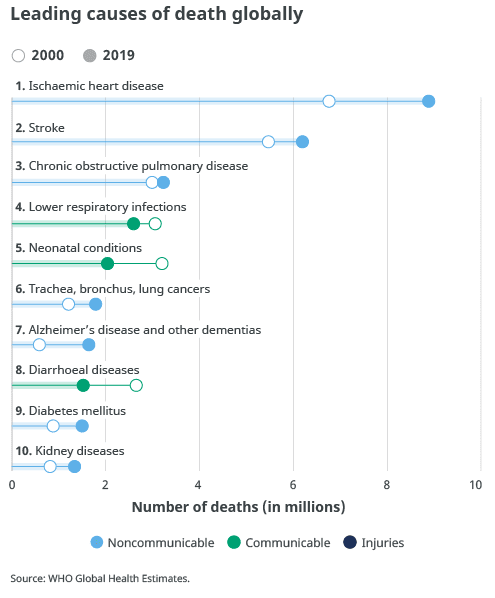Diseases like heart disease, diabetes, cancer, and stroke are leading causes of death worldwide. Poor diet, including overconsumption of saturated fat, trans fat, sodium, and sugar, are linked to increased risk of these diseases. For example, one quarter of deaths in Europe are attributed to poor diet. Despite decades of effort to educate global populations on the link between poor diet and preventable death, these nutrients are still overconsumed in most developed countries.

One strategy to improve public health is to reformulate foods to be healthier, which can have an effect at a population-level and does not necessarily rely on individual behaviour change to improve health. This can be initiated voluntarily by the food and beverage industry. For example, some companies have set public goals for reducing a nutrient like sodium in their foods by a certain percentage over a time period. In some parts of the world, reformulation is mandated. Greater improvements in sodium intakes have been shown in countries where is it mandatory rather than voluntary.
A recent scientific review titled “What is the impact of food reformulation on individuals’ behaviour, nutrient intakes and health status? A systematic review of empirical evidence” summarizes our existing knowledge of how effective food reformulation can be as a public health strategy by analyzing results of 35 published studies.
Results from the review
The review analyzed results from 35 published studies on food reformulation.
Consumers were accepting of reformulation of foods in the marketplace

A promising finding was that consumers still purchased reformulated products, meaning they didn’t specifically avoid foods formulated to be healthier. 22 different studies showed improvements in the nutrient content of the average consumer basket (total food purchased from a store).
81% of studies showed positive results for consumer acceptability of reformulated foods, based on comparing sales/purchases of the reformulated product before and after reformulation
Reformulation improved nutrient intake
73% of studies showed that reformulation improved nutrient intakes of consumers
Sodium reformulation led to a decrease in sodium intake between 4%-15% per year, depending on study population. Analysing studies from Europe and the US, the review found that daily population-wide salt intake after reformulation was 0.57g lower than before (equivalent to 221mg sodium), or equivalent to around 10% of the daily limit of 5 grams per day recommended by the World Health Organization.
Trans fat reformulation led to decreased intakes of 38-85%. This value is much higher than sodium because mandated trans fat reformulation laws require drastic reductions due to its clear link to heart disease. Partially hydrogenated oils, which are the main source of artificial trans fat in the diet, are not considered safe for the food supply in the United States, for example. In Europe, there is a maximum limit of 2 grams of trans fat per 100 grams of total fat in a food.
Trans fat reformulation and decreased mortality
Of the 6 studies which measured the impact of nutrient intake on morbidity or mortality rates, 5 showed a positive effect on reducing mortality
Five of the studies measuring effects on health status looked at trans fat reformulation and found that reducing trans fat in the food supply led to a reduction in mortality of 4.3-6.2%.
Sodium reformulation led to an improvement in blood pressure measurements in the UK. These findings show promise for nutrient reformulations to affect public health in a positive way.
Challenges for nutrient reformulation
Taste
Reducing nutrients that contribute strongly to the taste of a food or beverage, like sodium or sugar, without reducing consumer liking is the main challenge when it comes to nutrient reformulation.
For sugar, low-calorie sweeteners can drastically reduce total sugar content of a food or beverage. However, these sweeteners have their own challenges. They have poor perception among many consumers, and also bring their own flavour off-notes with them. They are also not recommended as a long-term strategy for reducing sugar content in foods by authority publications like the Dietary Guidelines for Americans.
Sodium reduction faces similar challenges because alternatives to sodium, like potassium chloride, also have off-notes. Many companies will slowly decrease sodium content in foods over a period of years because sodium sensing is adaptive. In other words, the less sodium someone is used to tasting, the less they need in a food to stimulate the same salty sensations. Gradually reducing sodium over time will be unnoticed by many consumers, as a result.
Flavour modulation, which can enhance the inherent sweetness in sugar, mask off-notes, or enhance mouthfeel or saltiness, is a great tool for nutrient reformulation. This technology is one way to reduce sugar without requiring low-calorie sweeteners or to mask notes of sodium or sugar alternatives.
Functionality
Sugar, sodium, and certain fats have roles in food beyond taste. Both sugar and sodium can have roles in food safety, as well as important roles in chemical reactions for many baked foods. These nutrients also have roles in moisture migration, shelf life, etc. Finding ways to minimize the impact of nutrient reformulation requires a system-level approach and in-depth expertise in food science and applications.

Fibers are seeing some popularity in low-sugar foods and beverages because of their ability to contribute bulk and mouthfeel, as well as sweetness in the case of some fibers. Fiber is under-consumed in many populations, so this could have additional benefits to public health.
Consumer perception
Due to the taste and functionality challenges listed above, many consumers will associate nutrient reformulations with less taste.
“Consumer acceptance is a key driver of the effectiveness of reformulation in changing dietary intakes, in the absence of which unwarranted substitutions may take place.”
The review summarised in this article found that, despite having high consumer acceptance, compensation for the nutrient content of reformulated foods did occur. Some studies did not find a link between reformulation and decreased intakes, or smaller decreases than predicted.
This happened more often when reformulation was noticed by consumers, possibly due to it being advertised on a package. Silent reformulation is one strategy that could be used to reduce the effect of compensation.
The study’s findings encourage future reformulation efforts
“Given the challenges involved in changing behaviours and food choices, reformulation can provide the means to improve dietary intakes and health by changing the environment in which people make their food choices. Nonetheless, the success of reformulation as a public health strategy crucially depends on the breadth of products reformulated and the extent to which they are reformulated.”
The study did not address energy density or calorie reduction, which is another reformulation initiative that is important to address the global obesity issue. Developing knowledge in sensory science and food science is critical to the future of not only calorie reduction, but nutrient reformulation as a whole.

 Nathan Pratt, PhD, RD is a nutrition scientist passionate about finding ways to make science easily used and understood to improve health. During his time working with the food and beverage industry he has worked with companies globally to bridge the gap between consumer insights and nutrition science and to better leverage nutrition in their strategies and product development.
Nathan Pratt, PhD, RD is a nutrition scientist passionate about finding ways to make science easily used and understood to improve health. During his time working with the food and beverage industry he has worked with companies globally to bridge the gap between consumer insights and nutrition science and to better leverage nutrition in their strategies and product development. 